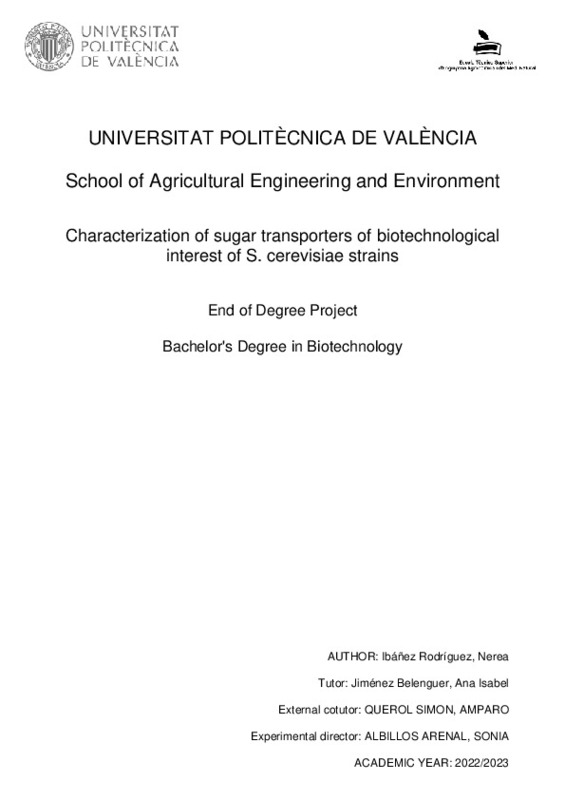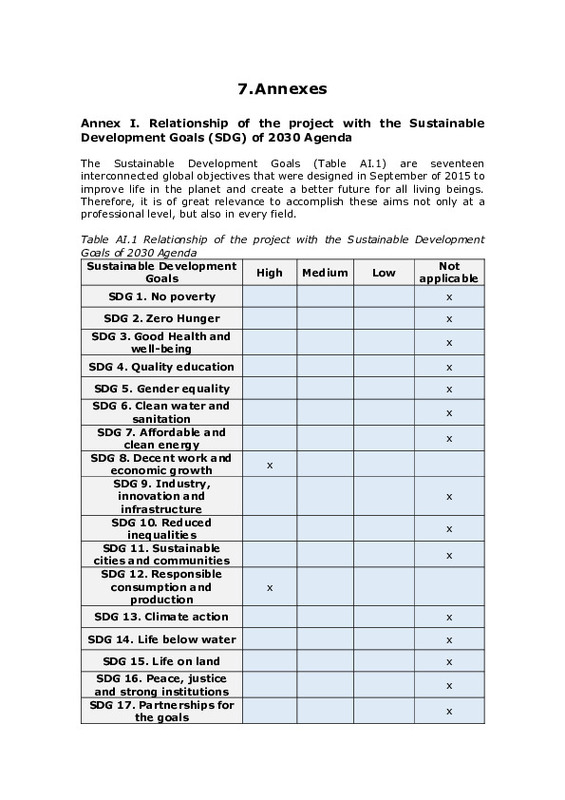|
Resumen:
|
[ES] La elaboración del vino se produce por la fermentación de las levaduras, que convierten el azúcar del mosto de las uvas en alcohol. Las levaduras más usadas para esto son las del género Saccharomyces. El transporte ...[+]
[ES] La elaboración del vino se produce por la fermentación de las levaduras, que convierten el azúcar del mosto de las uvas en alcohol. Las levaduras más usadas para esto son las del género Saccharomyces. El transporte de azúcares está regulado por las HXT, que son una gran familia multigénica.
Hay transportadores con baja afinidad, como el HXT1 y el HXT3. Cuando se expresan solamente estos transportadores, la fermentación completa de azúcares tiene lugar, por lo tanto, son muy importantes en la fermentación del vino.
Entre los transportadores de alta afinidad se encuentran el HXT2, HXT6 y el HXT7 y se requieren para la fermentación normal. Los transportadores HXT6 y HXT7 se requieren al final de la fermentación alcohólica. Para que la fermentación alcohólica tenga éxito, se necesitan al menos cuatro o cinco transportadores de hexosa, cada uno con una función diferente en diversas etapas de la fermentación.
Debido a la gran similitud de la secuencia de HXT6 y HXT7, pueden ocurrir recombinaciones entre cepas de Saccharomyces, cada una con recombinaciones distintas, por lo que se utilizarán los haplotipos. Para poder estudiar la función de HXT6 y HXT7 en levaduras, a la cepa V5 MTF 255, que está modificada genéticamente sin HXTs, se le introducirán HXTs de otras cepas.
En el proyecto se comprobará que la cepa V5 MTF 255 tiene la región correcta del genoma, y se hará una transformación para introducir el gen de HXT6 de cepas de interés en la cepa V5 MTF 255, que se clonará. Para esto se diseñarán los cebadores.
Posteriormente se utilizarán oligos de verificación para amplificar la región del genoma de VS MTF 255 donde se ha introducido el gen, con el fin de después secuenciarla, y, de esta forma, comprobar que el fragmento de DNA se ha introducido en el lugar correcto del genoma. De esta manera, se conseguirá la cepa deseada que contiene cada HXT.
Con esta cepa podremos comprobar si las levaduras con HXTs recombinadas obtienen y procesan la glucosa y la fructosa de la misma manera que las levaduras con HXTs que no se han recombinado, o esta varía. Esto será útil para mejorar la fermentación realizada por las levaduras con el fin de obtener vino.
[-]
[EN] Wine elaboration is produced by yeast fermentation, that transforms the sugar of the grape must into alcohol. The yeasts most used for this are the ones of the Saccharomyces genus. Sugar transport is regulated by the ...[+]
[EN] Wine elaboration is produced by yeast fermentation, that transforms the sugar of the grape must into alcohol. The yeasts most used for this are the ones of the Saccharomyces genus. Sugar transport is regulated by the HXT, that are a big multigenic family.
There are transporters with low affinity, such as the HXT1 and the HXT3. When only these transporters are expressed, the complete sugar fermentation takes place, therefore, they are very important in wine fermentation.
Among the transporters of high affinity, the HXT2, HXT6 and HXT7 can be found, and they are required for normal fermentation. HXT6 and HXT7 transporters are required at the end of the alcoholic fermentation. For this fermentation being successful, al least four or five hexose transporters are needed, each with a different function in the diverse stages of the fermentation.
Due to the high similarity of HXT6 and HXT7 sequences, recombinations between Saccharomyces strains could have happened. Each strain would have different recombinations, so haplotypes will be used. To study the function of HXT6 and HXT7 in yeasts, into the strain V5 MTF 255, that is genetically modified without HXTs, HXTs of other strains will be introduced.
In the project it will be proved that the strain V5 MTF 255 has the correct region of the genome, and a transformation will be done to introduce the HXT6 gene of strains of interest in V5 MTF 255 strain, that will be cloned. For this, primers will be designed.
After this, verification primers will be used to amplify the genome region of V5 MTF 255 where the gene has been introduced to then sequence it and, in this way, prove that the DNA fragment has been introduced in the correct region of the genome. In this way, the desired strain with each HXT will be obtained.
With this strain we will be able to prove if the yeasts with recombined HXTs obtain and process the glucose and fructose in the same way as the yeasts with not-recombined HXTs, or it varies. This will be useful to improve the fermentation performed by yeasts to obtain wine.
[-]
|
|
Agradecimientos:
|
This project has received funding from the Spanish government
and EU ERDF-FEDER projects PID2021-126380OB-C31 and PID2021-
126380OB-C33 to AQ and EB, respectively. IATA-CSIC received funding from
the Spanish government, ...[+]
This project has received funding from the Spanish government
and EU ERDF-FEDER projects PID2021-126380OB-C31 and PID2021-
126380OB-C33 to AQ and EB, respectively. IATA-CSIC received funding from
the Spanish government, ref. MCIN/AEI/10.13039/501100011033, as a
‘Severo Ochoa’ Center of Excellence (CEX2021-001189-S), with AQ as PI.
[-]
|








